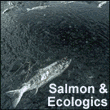forum
library
tutorial
contact

Compact to Adopt Net Season
by Allen Thomas, Columbian staff writerThe Columbian, July 29, 2004
|
the film forum library tutorial contact |

|
Compact to Adopt Net Seasonby Allen Thomas, Columbian staff writerThe Columbian, July 29, 2004 |
Washington and Oregon officials meet today in Longview to adopt the first of the fall gillnet seasons in the lower Columbia River.
The session of the Columbia River Compact starts at 10 a.m. at the Cowlitz Public Utility District office, 961 12th Ave.
A framework for splitting the non-Indian share of the Columbia's fall chinook salmon run is negotiated each March and April.
Specific dates for commercial harvest of fall chinook, coho and sturgeon then are adopted in-season, beginning in late July and continuing into October.
Fall salmon management is a complicated balancing act of splitting the harvest between tribal and non-Indian fishermen, then between non-Indian sport and commercial fishermen and even between sportsmen in different stretches of the lower Columbia.
Wild Snake River fall chinook salmon are protected under the federal Endangered Species Act. An agreement between Washington, Oregon, the tribes and the federal government caps the harvest of the upriver bright stock of fall chinook at 31.29 percent to protect those wild Snake River fish.
That 31.29 percent is split 8.25 percent for non-Indians downstream of Bonneville Dam and 23.04 percent for the treaty tribes in the Bonneville, The Dalles and John Day pools.
The non-Indian share of 8.25 percent is split 52 percent for the sports fishery and 48 percent for the commercials.
The allocation framework sets out expectations for how the fall seasons will managed.
For the commercials, the framework calls for:
learn more on topics covered in the film
see the video
read the script
learn the songs
discussion forum
